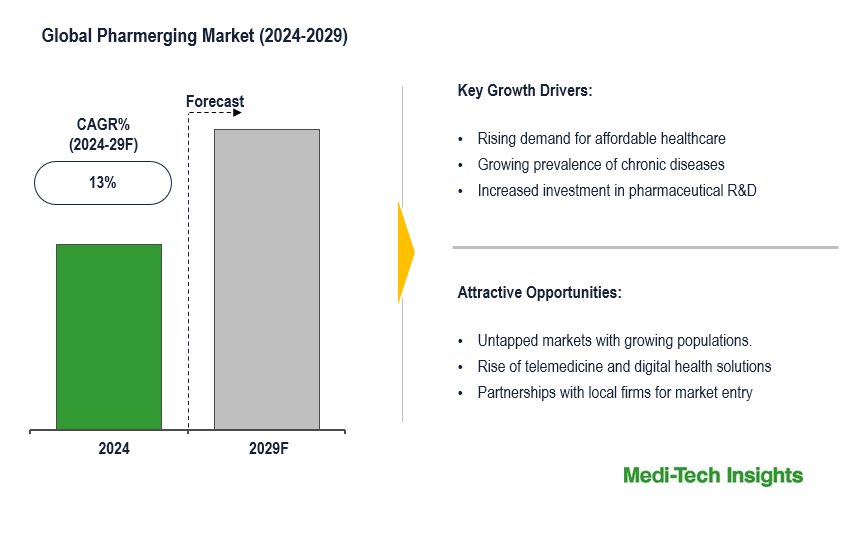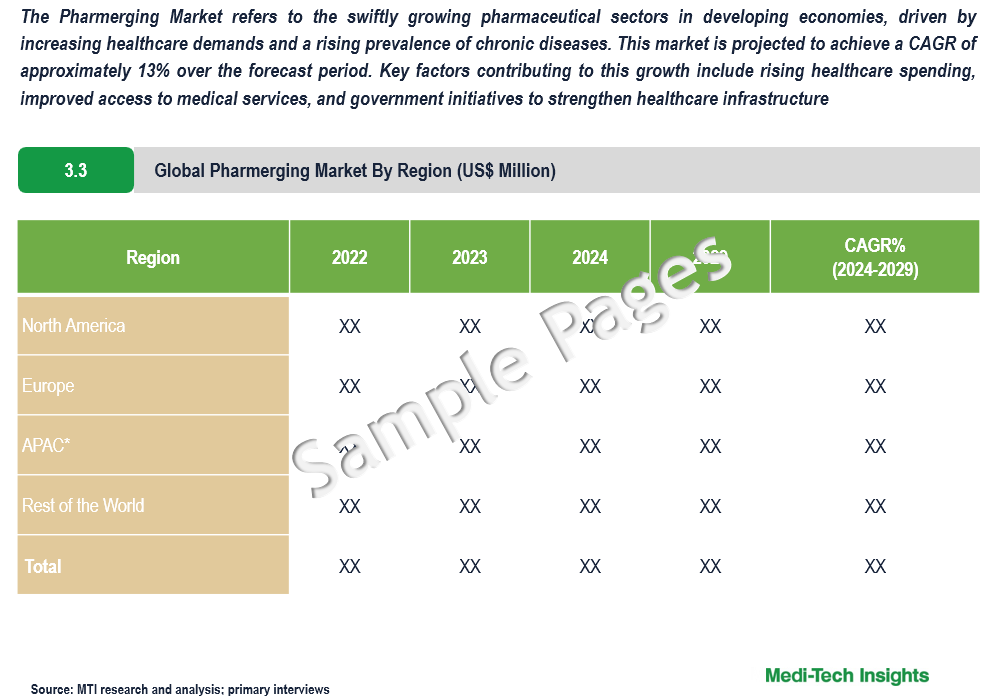
Pharmerging Market Size, Trends, Share, Industry Growth Analysis and Forecast 2024 to 2029
The Pharmerging Market refers to the swiftly growing pharmaceutical sectors in developing economies, driven by increasing healthcare demands and a rising prevalence of chronic diseases. This market is projected to achieve a CAGR of approximately 13% over the forecast period. Key factors contributing to this growth include rising healthcare spending, improved access to medical services, and government initiatives to strengthen healthcare infrastructure. To learn more about the research report, download a sample report.
The pharmerging market is a fast-growing segment of the global pharmaceutical industry, marked by accelerated expansion in developing economies. Concentrated in regions such as Asia, Latin America and other developing regions, these markets are seeing a surge in demand for pharmaceutical products, fueled by economic growth and shifting healthcare needs. With advancements in healthcare infrastructure and wider access to medical services, the consumption of medications and healthcare products is rising steadily, making pharmerging markets pivotal to the global expansion strategies of pharmaceutical companies.
Unfolding Dynamics in the Growth of Pharmerging Markets
The pharmerging market is flourishing due to several key factors. First, the economic rise in countries like China, India, and Brazil has led to improved living standards, increased healthcare expenditure, and expanded access to medical services. Secondly, aging populations and the rise in non-communicable diseases, such as diabetes, cardiovascular diseases, and cancer, have escalated the need for chronic disease management and medications. Additionally, government initiatives aimed at improving healthcare infrastructure, increasing health insurance coverage, and promoting domestic pharmaceutical manufacturing are further accelerating market growth. Global pharmaceutical companies are also expanding their presence in these regions, drawn by the prospect of double-digit growth rates.
To learn more about this report, download the PDF brochure
Key Developments Transforming Pharmerging Markets
Several emerging trends are shaping the future of the pharmerging market. One notable trend is the increasing adoption of biosimilars and generics, driven by the rising demand for cost-effective treatment options. Digital health technologies, such as telemedicine and health apps, are also gaining momentum, particularly in markets where healthcare access remains a challenge in rural areas. Additionally, personalized medicine and innovative treatment approaches are beginning to penetrate these markets as governments and healthcare providers focus on more efficient, patient-centered care. The integration of artificial intelligence and data analytics into healthcare systems is further enhancing diagnostic capabilities and treatment outcomes, contributing to the evolution of healthcare in these regions.
Challenges and Constraints
The pharmerging market faces several challenges including varying regulations across different countries, which can complicate drug approvals and market entry. Additionally, ensuring the safety and efficacy of pharmaceuticals is difficult in regions with less stringent oversight, leading to potential quality control issues. The market's fragmentation, driven by diverse healthcare systems and conditions, can create product availability and pricing inconsistencies. Intellectual property concerns, due to weak enforcement of rights, may deter investment and innovation. Economic instability in developing nations can also affect healthcare spending and investment in the pharmaceutical sector. Furthermore, supply chain disruptions, intensified by geopolitical tensions and logistical challenges, can impede the timely delivery of essential medications and raw materials, jeopardizing overall market stability.
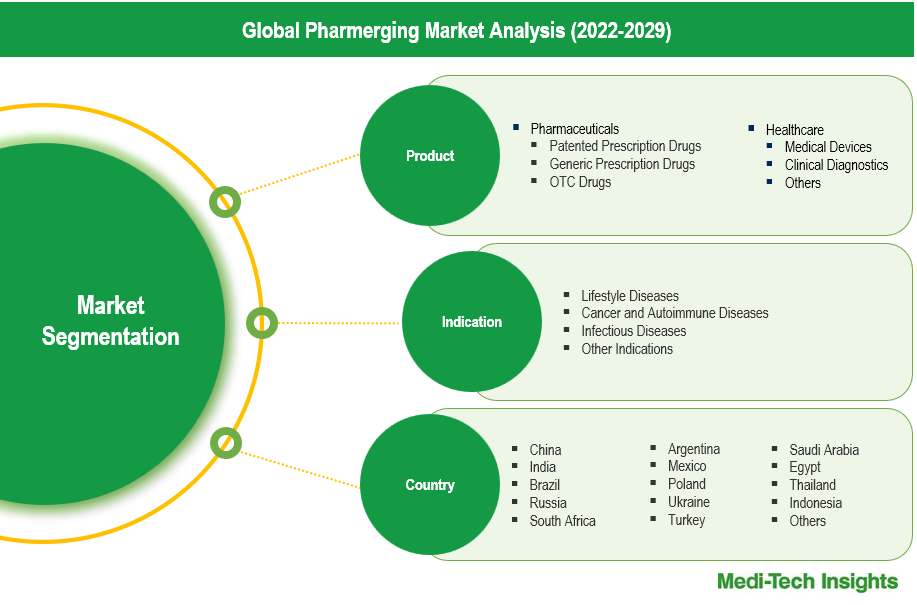
To learn more about this report, download the PDF brochure
Product Segment Outlook
The pharmerging market is shaped by a broad range of product segments, with pharmaceuticals at the forefront. Patented prescription drugs hold a key position, driven by the growing demand for innovative therapies, particularly for chronic and complex diseases. Generic prescription drugs are also a major growth area, benefiting from their affordability and strong government backing to improve access to essential medicines. Over-the-counter (OTC) drugs are seeing rising demand as self-medication trends increase and non-prescription treatments become more accessible. In the healthcare sector, medical devices are gaining prominence, fueled by technological advancements and the development of healthcare infrastructure. Clinical diagnostics are becoming increasingly important, with the rising need for accurate and timely disease detection. Additionally, healthcare services and related technologies add a further dimension to the market, complementing the expansion of both pharmaceuticals and diagnostics.
End User Segment Outlook
The pharmerging market by indication is segmented into lifestyle diseases, cancer and autoimmune diseases, infectious diseases, and other diseases. Lifestyle diseases such as diabetes, cardiovascular conditions, and obesity leading the charge due to the increasing prevalence of unhealthy lifestyles and aging populations. Cancer and autoimmune diseases follow closely, driven by advancements in targeted therapies and a growing need for specialized treatments. Infectious diseases continue to be a key area, particularly in developing regions, where efforts to combat epidemics and improve access to vaccines are crucial. Other indications, including rare diseases and mental health conditions, contribute further to market growth as healthcare needs diversify across emerging economies.
Regional Dynamics of the Pharmerging Market
The pharmerging market is not homogenous but varies significantly across different regions. China, the largest pharmerging market, stands out due to its massive population, rapid urbanization, and aggressive government policies aimed at boosting domestic pharmaceutical production. India follows closely, benefiting from its status as the world's largest supplier of generic medicines. Latin American countries like Brazil and Mexico are witnessing similar growth patterns, supported by government-led healthcare reforms and increasing healthcare access. In Eastern Europe and Southeast Asia, countries like Russia and Indonesia are also emerging as important markets, although they face challenges like regulatory complexities and uneven healthcare infrastructure development. These regional dynamics highlight the diverse opportunities and challenges that pharmaceutical companies encounter as they navigate the pharmerging landscape.
Competitive Landscape Analysis
The pharmerging market key players include Pfizer Inc., Sanofi, AstraZeneca, GlaxoSmithKline Plc, F. Hoffmann-La Roche Ltd., GE Healthcare, Eli Lilly and Company, Medtronic, Abbott Laboratories, Novartis AG and Johnson & Johnson among others.
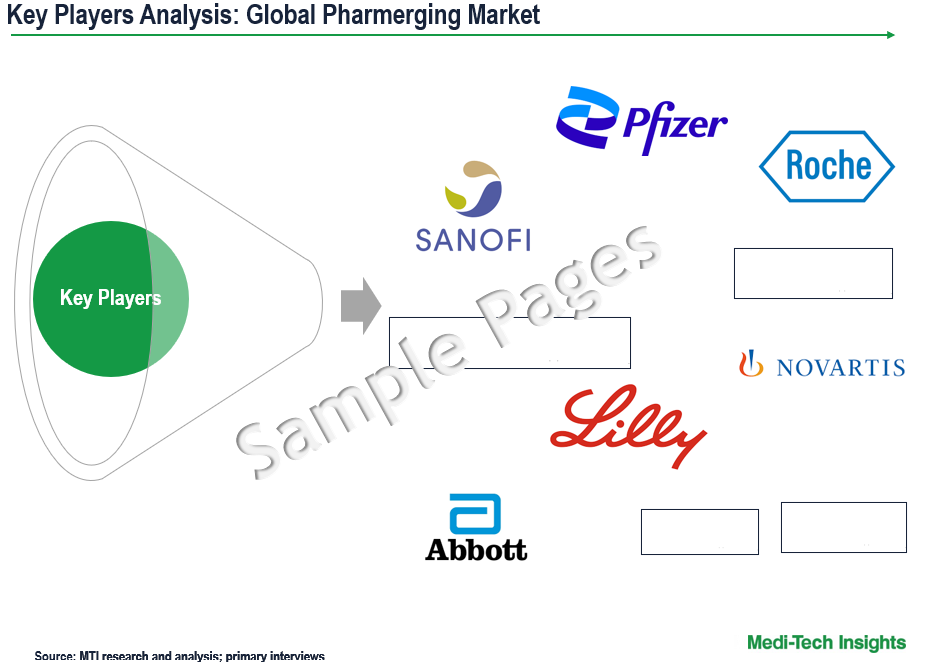
Get a sample report for competitive landscape analysis
Organic and Inorganic Growth Strategies Adopted by Players to Establish Their Foothold in the Market
Players operating in this market are adopting both organic and inorganic growth strategies such as collaborations, acquisitions, and new product launches to garner market share. For instance,
- In June 2024, Eli Lilly and Company announced a collaboration with OpenAI to harness OpenAI's generative AI technology for the invention of novel antimicrobials aimed at treating drug-resistant pathogens
- In May 2024, Sanofi, Formation Bio, and OpenAI announced a groundbreaking collaboration to create AI-powered software designed to expedite drug development and efficiently deliver new medicines to patients, combining data, software, and tailored models to develop specialized solutions throughout the drug development lifecycle
- In July 2023, Illumina Inc. and Pillar Biosciences Inc. formed a strategic partnership to globally commercialize Pillar's oncology assays within the Illumina portfolio of oncology products. This collaboration aims to provide a comprehensive range of next-generation sequencing solutions, improving the precision, cost-effectiveness, and accessibility of oncology testing
- In June 2023, AstraZeneca embarked on an intriguing collaboration, signing an exclusive option and license agreement with Quell Therapeutics. The partnership aims to develop several engineered T-regulator (Treg) cell therapies, which hold promise as potential cures for Type 1 Diabetes (T1D) and Inflammatory Bowel Disease (IBD) indications
- In August 2022, Atomwise announced a strategic and exclusive research collaboration with Sanofi, utilizing its AtomNet platform for the computational discovery and research of five drug targets
The market is growing and is expected to gain further momentum in the coming years due to the rising demand for affordable healthcare, increased investment in pharmaceutical R&D, growing prevalence of chronic diseases, technological advancements, and aggressive organic and inorganic growth strategies followed by the players.
Global Pharmerging Market Scope
|
Report Scope |
Details |
|
Base Year Considered |
2023 |
|
Historical Data |
2022 - 2023 |
|
Forecast Period |
2024 - 2029 |
|
Growth Rate |
CAGR 13% |
|
Segment Scope |
Product, Indication and Country |
|
Regional Scope |
|
|
Key Companies Mapped |
Pfizer Inc., Sanofi, AstraZeneca, GlaxoSmithKline Plc, F. Hoffmann-La Roche Ltd., GE Healthcare, Eli Lilly and Company, Medtronic, Abbott Laboratories, Novartis AG and Johnson & Johnson among others |
|
Report Highlights |
Market Size & Forecast, Growth Drivers & Restraints, Trends, Competitive Analysis |
Key Strategic Questions Addressed
-
What is the market size & forecast for the Global Pharmerging Market?
-
What are the historical, present, and forecasted market shares and growth rates of various segments and sub-segments of the Global Pharmerging Market?
-
How has COVID-19 impacted the Global Pharmerging Market?
-
What are the major growth drivers, restraints/challenges impacting the market?
-
What are the opportunities prevailing in the market?
-
What is the investment landscape?
-
Which region has the highest share in the global market? Which region is expected to witness the highest growth rate in the next 5 years?
-
Who are the major players operating in the market? What is the competitive positioning of key players?
-
Who are the new players entering the market?
-
What are the key strategies adopted by players?
- Introduction
- Introduction
- Market Scope
- Market Definition
- Segments Covered
- Regional Segmentation
- Research Timeframe
- Currency Considered
- Study Limitations
- Stakeholders
- List of Abbreviations
- Key Conferences and Events (2023-2024)
- Research Methodology
- Secondary Research
- Primary Research
- Market Estimation
- Bottom-Up Approach
- Top-Down Approach
- Market Forecasting
- Executive Summary
- Pharmerging Market Snapshot (2023-2029)
- Segment Overview
- Regional Snapshot
- Competitive Insights
- Market Overview
- Market Dynamics
- Drivers
- Rising demand for affordable healthcare
- Increased investment in pharmaceutical R&D
- Growing prevalence of chronic diseases
- Expansion of healthcare infrastructure
- Increase in access to healthcare services
- Restraints
- Regulatory hurdles and varying approval processes
- Competition from established pharmaceutical markets
- Economic instability in certain regions
- Opportunities
- Untapped markets with growing populations
- Rise of telemedicine and digital health solutions
- Key Market Trends
- Shift towards personalized medicine
- Adoption of advanced technologies (AI, big data) in healthcare
- Unmet Market Needs
- Industry Speaks
- Porter’s Five Forces Analysis
- Regulatory Analysis
- Drivers
- Market Dynamics
- Global Pharmerging Market Size & Forecast (2022-2029), By Product Type, USD Million
- Introduction
- Pharmaceuticals
- Patented Prescription Drugs
- Generic Prescription Drugs
- OTC Drugs
- Healthcare
- Medical Devices
- Clinical Diagnostics
- Others
- Global Pharmerging Market Size & Forecast (2022-2029), By Indication, USD Million
- Introduction
- Lifestyle Diseases
- Cancer and Autoimmune Diseases
- Infectious Diseases
- Other Indications
- Global Pharmerging Market Size & Forecast (2022-2029), By Country, USD Million
- Introduction
- Pharmerging Market Size & Forecast (2022-2029), By Country, USD Million
- China
- Market Size & Forecast, By Product (USD Million)
- Market Size & Forecast, By Indication (USD Million)
- India
- Market Size & Forecast, By Product (USD Million)
- Market Size & Forecast, By Indication (USD Million)
- Brazil
- Market Size & Forecast, By Product (USD Million)
- Market Size & Forecast, By Indication (USD Million)
- Russia
- Market Size & Forecast, By Product (USD Million)
- Market Size & Forecast, By Indication (USD Million)
- South Africa
- Market Size & Forecast, By Product (USD Million)
- Market Size & Forecast, By Indication (USD Million)
- Argentina
- Market Size & Forecast, By Product (USD Million)
- Market Size & Forecast, By Indication (USD Million)
- Mexico
- Market Size & Forecast, By Product (USD Million)
- Market Size & Forecast, By Indication (USD Million)
- Poland
- Market Size & Forecast, By Product (USD Million)
- Market Size & Forecast, By Indication (USD Million)
- Ukraine
- Market Size & Forecast, By Product (USD Million)
- Market Size & Forecast, By Indication (USD Million)
- Turkey
- Market Size & Forecast, By Product (USD Million)
- Market Size & Forecast, By Indication (USD Million)
- Saudi Arabia
- Market Size & Forecast, By Product (USD Million)
- Market Size & Forecast, By Indication (USD Million)
- Egypt
- Market Size & Forecast, By Product (USD Million)
- Market Size & Forecast, By Indication (USD Million)
- Thailand
- Market Size & Forecast, By Product (USD Million)
- Market Size & Forecast, By Indication (USD Million)
- Indonesia
- Market Size & Forecast, By Product (USD Million)
- Market Size & Forecast, By Indication (USD Million)
- Other Countries
- China
- Competitive Landscape
- Key Players and their Competitive Positioning
- Competitive Positioning of Key Players (2022)
- Offerings Assessment, By Player
- Key Strategies Assessment, By Player (2021-2023)
- New Product & Service Launches
- Partnerships, Agreements, & Collaborations
- Mergers & Acquisitions
- Geographic Expansion
- Key Players and their Competitive Positioning
- Company Profiles*
(Business Overview, Financial Performance**, Products Offered, Recent Developments)
- Pfizer Inc.
- Sanofi
- AstraZeneca
- GlaxoSmithKline Plc
- Hoffmann-La Roche Ltd.
- GE Healthcare
- Eli Lilly and Company
- Medtronic
- Abbott Laboratories
- Novartis AG
- Johnson & Johnson
- Other Prominent Players
The study has been compiled based on extensive primary and secondary research.
Secondary Research (Indicative List)
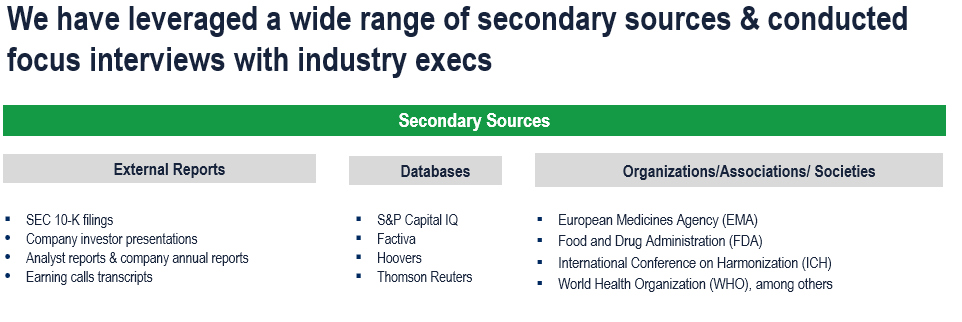
Primary Research
To validate research findings (market size & forecasts, market segmentation, market dynamics, competitive landscape, key industry trends, etc.), extensive primary interviews were conducted with both supply and demand-side stakeholders.
Supply Side Stakeholders:
- Senior Management Level: CEOs, Presidents, Vice-Presidents, Directors, Chief Technology Officers, Chief Commercial Officers
- Mid-Management Level: Product Managers, Sales Managers, Brand Managers, Business Development Managers, Consultants
- Demand Side Stakeholders: Stakeholders in Hospitals, Retail Pharmacies, and Online Stores among others
Breakdown of Primary Interviews
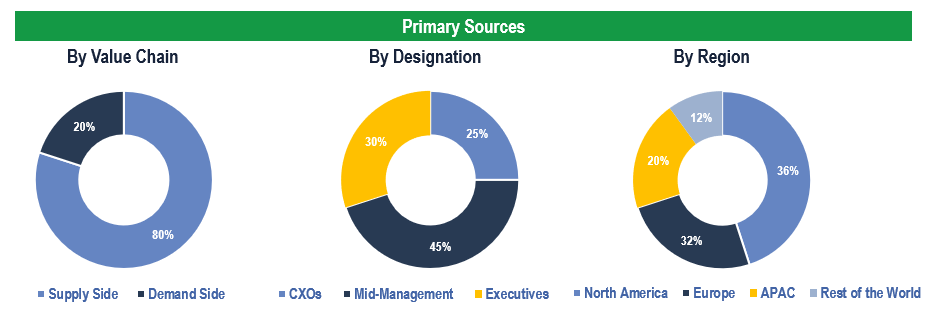
Market Size Estimation
Both ‘Top-Down and Bottom-Up Approaches’ were used to derive market size estimates and forecasts.
Data Triangulation
Research findings derived through secondary sources & internal analysis were validated with Primary Interviews, Internal Knowledge Repository, and Company Sales Data.

